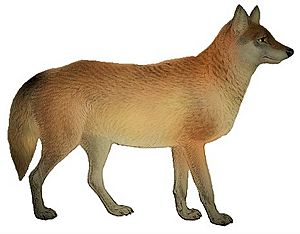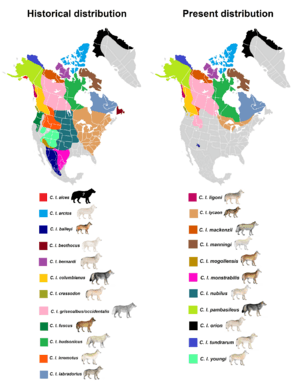Cascade mountain wolf facts for kids
The Cascade Mountains wolf (Canis lupus fuscus) was a type of gray wolf that used to live in the Pacific Northwest region of North America. This area includes parts of British Columbia in Canada, and Oregon and Washington in the United States. Sadly, this wolf subspecies became extinct in 1940, meaning there are no more of them alive today.
Quick facts for kids Cascade Mountains wolf |
|
|---|---|
 |
|
| Illustration based on a description by Edward Alphonso Goldman | |
| Conservation status | |
|
Extinct (1940)
|
|
| Scientific classification |
|
| Kingdom: | Animalia |
| Phylum: | Chordata |
| Class: | Mammalia |
| Order: | Carnivora |
| Family: | Canidae |
| Genus: | Canis |
| Species: | |
| Subspecies: |
†C. l. fuscus
|
| Trinomial name | |
| Canis lupus fuscus Richardson 1839
|
|
 |
|
| Historical and present range of gray wolf subspecies in North America | |
| Synonyms | |
|
|
About the Cascade Mountains Wolf
The Cascade Mountains wolf was first identified as a unique type of wolf in 1839 by a scientist named Richardson. Later, in 1945, another scientist named Edward Alphonso Goldman also described it as different from other wolves in the area. Today, it is officially recognized as a subspecies of the gray wolf.
This wolf was known for its beautiful cinnamon-colored fur. It was quite large, measuring about 165 centimeters (about 5.4 feet) long. It weighed between 36 and 49 kilograms (about 79 to 108 pounds).
What Happened to Them?
The Cascade Mountains wolf disappeared completely by 1940. This means it became extinct. Many factors can lead to a species becoming extinct, often including habitat loss and hunting.
Wolves Return to the Cascades
Even though the Cascade Mountains wolf is gone, another type of wolf, the British Columbia wolf (Canis lupus columbianus), has started to move into the same areas. These wolves are following the Cascade Range through Washington and are now found west of the Cascade mountains.
They are also spreading across Oregon and have even reached northern California. In 2019, a group of wolves called the Lassen pack had three pups near Lassen Peak in California. This shows that wolves are slowly returning to parts of their old territories.

